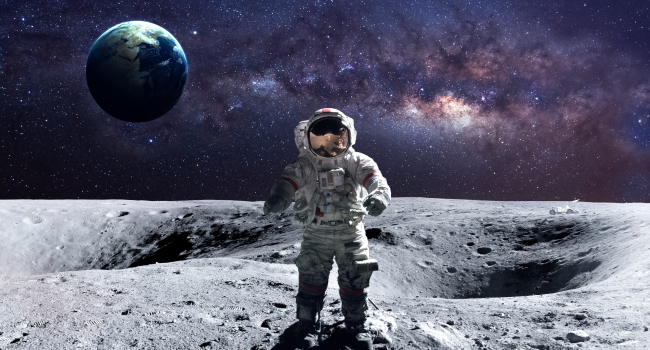
Why is it so difficult to send people to the Moon today?
In the years 1969-1972, as part of the Apollo missions, in general, dozens of astronauts landed on the surface of the Moon. Moreover, this happened before the rapid development of today's technology began. And the question arises, why is it that the current efforts of mankind to return to the Moon, in the form of NASA's Artemis project, seem to be so slow and complicated? It turns out that the question does not have one easy answer, because it depends on at least three factors: funding, politics and priorities, writes Space.com.
Funding
The Apollo missions were extremely successful and extremely expensive. At the time, NASA consumed about 5% of the entire US federal budget, and more than half of that was allocated to the Apollo program. Adjusted for inflation, the entire Apollo project would cost more than $260 billion today. If we take into account the Gemini project and the lunar robotics program, which were necessary prerequisites for the implementation of Apollo, this number will reach more than 280 billion dollars.
By comparison, NASA today commands less than half a percent of the total federal budget, with a much wider range of priorities and mandates. Over the past decade, NASA has spent about $90 billion on the Artemis mission. And since less money is now being allocated to land on the moon again, progress on this issue will likely be slower, even with the development of technology.
Politics
Political realities are also closely related to financial realities. In the 1960s, the United States was in a race with the Soviet Union to achieve as many achievements as possible in space exploration, to be first in many matters, especially landing men on the moon. The public was on board and enthusiastic about the idea, as were lawmakers directing NASA's large budget.
That kind of spending, however, was deeply unsustainable, and when the US "won" the issue, the public quickly lost interest and NASA's funding dwindled. There is simply no political or public will to spend that money for a second landing on the Moon.
This combination of less political will and fewer financial resources forced NASA to make critical decisions in the late 1990s and early 2000s, decisions that affect the Artemis mission today. In particular, when the Space Shuttle program was ending, NASA administrators did not know what to do with the infrastructure and collaborations that had made the project possible. In the end, they decided to keep that infrastructure, reusing many of its parts, especially the engines, and eventually combined them into the Artemis project.
Priorities
Today's concept of Project Artemis has very different priorities than the Apollo missions. For example, today's tolerance for risk is much lower than it was in the 1960s. The Apollo missions were quite dangerous, with a high probability of failure. Several missions ended in disaster. Examples include the Apollo 1 fire that killed three astronauts, the engine shutdown during Apollo 6, and a design flaw that could have killed nearly 13 Apollo astronauts. NASA, lawmakers, and the public today are reluctant to take that risk again, especially after the Challenger and Columbia disasters.
Huge sums of money were spent on the Apollo missions. astronauts were sent to the Moon for several tens of hours, where they descended to the surface of the Moon, collected samples, performed simple experiments and returned.
But Artemis missions are designed around completely different goals. First, astronauts must spend up to a week on the lunar surface, which requires more food, water, fuel and scientific instruments. Second, while science took a backseat to the Apollo missions (the main goal was to get to the Moon early and outrun the Soviet Union), scientific research would take center stage in the Artemis project. This means that the preparation for this mission is more complicated and time-consuming.
And finally, the purpose of the Artemis program is not merely to return humans to the Moon; it aims to initiate the construction of infrastructure to enable permanent human presence there. The Artemis project includes everything from orbital refueling depots to site selection for future colonies. It is a much more involved program as it provides the framework to fulfill the dreams of future generations.
- Related News
- Wheel of Death: new method will help astronauts stay fit in low gravity
- Due to anomalies of Orion spacecraft, lunar exploration program may be delayed for years։ NASA
- TAO Observatory: World's highest telescope to study evolution of galaxies and exoplanets
- Powerful M9.5 solar flare causes radio blackout in Pacific Ocean
- What will happen to the Earth if the Moon disappears?
- Key to conquering the Red Planet: Why is NASA studying solar storms on Mars?
- Most read
month
week
day
- Digital Julfa Network is launching a pan-Armenian centre in the metaverse, on the Fastexverse virtual platform 853
- Sparkles: Boston Dynamics unveils a furry robot dog that can dance (video) 766
- Xiaomi unveils exclusive Redmi Note 13 Pro+ dedicated to Messi and Argentina national team 719
- Is there a ninth planet in the solar system? Scientists find new evidence 652
- Smartphone catches fire in child's hand in Russia 652
- What will happen to the Earth if the Moon disappears? 621
- How to understand how protected a smartphone is from water and dust? 619
- World's largest 3D printer was created in USL It prints 29 meter-long structures 616
- New iPad Pro to receive M4 chip and to be more powerful than Apple computers 592
- iPhone 16 may get colored matte glass back panel, 7 colors 591
- Archive
